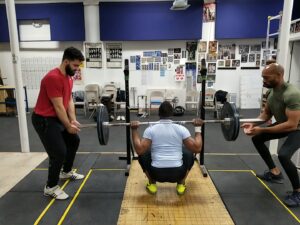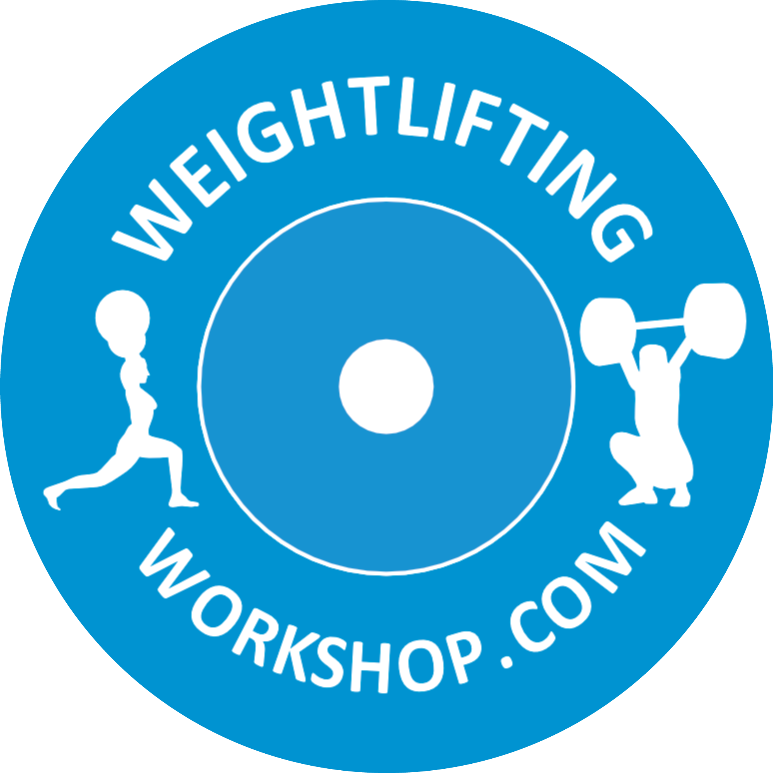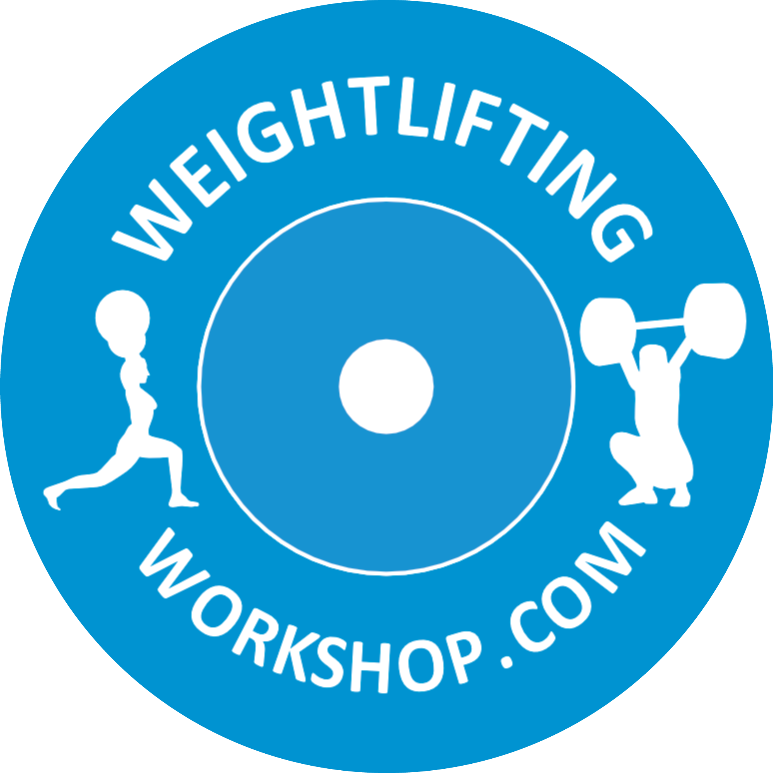
If you look at videos of even some very high level lifters performing squats, you’ll see that many squat without a spot, or use a single spotter. We don’t recommend either of these approaches to squatting, especially when lifters are using weights they might reasonably struggle with, or possibly miss.
Squatting Without A Spotter
Most lifters can learn to “dump” the bar behind them when they miss a squat (by pushing back on the bar to throw it well behind the lifter’s hips and then letting go of the bar and jumping forward to get out from under the falling bar). But we don’t recommend such as approach for at least two reasons. First, if something should go wrong during the squat (e.g., the lifter grows dizzy or sustains an injury like a quadriceps strain) that lifter may not be successful when dumping the bar is attempted, leading to a more serious problem.
Second, whenever lifters have to divide their attention between pushing up on the bar and deciding whether or not to abandon an attempt, that lowers their ability to go all out in terms of squatting effort. In short, multitasking while squatting is a bad idea.
Squatting With A Single Spotter
Using one person for a spot is not a good idea either, unless the spotter is so strong that stopping the bar when a squat is missed is easy for that spotter (e.g., the lifter is squatting with 100 kg. and the spotter can deadlift 300 kg.). Otherwise, the spotter may not be able to control the bar comfortably if a squat is missed.
In addition, a spotter standing behind a lifter can impede the lifter’s ability to dump a missed squat, either by being in the way of the falling bar, or by causing the lifter to avoid dropping the bar because that lifter is afraid of hurting the spotter if the bar is dumped.
Squatting With Two Spotters – Clearly A Better Way If Done Correctly
A much better alternative to no spotter, or a single spotter, is a two-person spot. It is generally safest alternative to squatting in a cage and is recommended whenever a lifter is going heavy. Properly trained, two spotters can provide very safe spotting – not as good as a power rack or cage, but much safer than the safety that a single spotter can generally offer. However, such spotting has to be done in a very specific way to insure the maximum of safety.
Naturally, the spotters must each be strong enough to comfortably lift their side of the bar if necessary. The lifter will usually be able to help in the event of a miss, but you can’t count on that. If the lifter fails to push up on the bar to help the spotters (which could happen because of forgetfulness, disappointment over the miss, or even an injury), the spotters must be able to stop the downward progress of the barbell and safely return it to the rack or, if appropriate, the floor, without the lifter’s help.
Next, the spotters need to have a place for solid footing at their end of the bar. Sometimes plates or other items are left next to rack, impeding the spotter’s ability to get near and catch the bar. Any significant distance between the body of the spotter and the bar gives them poor leverage when they try to assist. If any objects keep the spotters body from being right next to the end of the bar, these must be removed before the spot begins.
How Good Spotters Work Together Without Looking At Each Other
To spot safely and effectively, the two spotters must have each been trained focus solely on stopping their end of the bar should their assistance be needed. Having only one spotter trained in such a way is very dangerous, as the untrained spotter may go about spotting in a much different way. It is not safe to mix spotting styles. Appropriate spotter training can be given very quickly and simply, but it must be given to all spotters if they are to spot the lifter they are assisting it a safe manner.
They need to keep their hands just below the bar (e.g., perhaps a half inch) throughout the lift, so that there is no contact with the bar, but there is also an ability to immediately contact the bar as necessary. The spotters shouldn’t look at the lifter but rather focus on their end of the bar. They have one simple job – grab the bar immediately should it at any time do either of two things – 1) it continue to downward after it has reached the lowest possible position that was expected at the bottom of the squat of that lifter, or, 2) the bar starts to go downward after it has initially been driven upward.
As soon as the lifter removes the barbell from the rack, the spotters need to place and keep their keep their hands just below the bar as was described above, so that there is no contact with the bar, but they have the ability to immediately grab the bar if necessary. Their bodies must also be close to the bar, and hands. The arms should not be outstretched to enable their hands to be under the bar, but rather the arms should be almost directly above the wrists. This close proximity gives them the crucial good leverage they need for a strong spot.
What The Spotters Must Be Laser Focused On
Let me emphasize that the spotters shouldn’t look at the lifter but rather their end of the bar. They will likely see the lifter with their peripheral vision and that is good. But they have one simple job – focus on what the end of the bar is doing. Their job during the descent of the barbell and lifter into to the squat is to keep their hands just below, never touching, the bar at that point in the lift.
However, this close positioning of the hands to the bar puts the spotters in the crucial position of being able to grab the bar immediately should it at any time and for any reason to begin to go unexpectedly downward – either once the lifter has reached the lowest possible position that was expected at the bottom of the squat, or once the lifter has started go downward after the bar was initially driven upward.
The bar is not touched if it stops, although the spotters should move closer when this happens and pay even closer attention to the bar. If the bar then begins to go down, that attempt at the lift should be considered over and the spotters should do their work, first stopping the barbell’s downward motion and then working in concert to raise the bar up, hopefully with the lifter’s assistance, to place it back on the rack. If this is not possible, the spotters simply stop the bar and then gently lower it to the floor (of course making sure they are not lowering it on top of the lifter).
Note that the spotters only begin to work in communication with one another when they are replacing the bar on the rack or floor – that is, after the bar has been stopped, as stopping the bar is the first priority.
Why does this work so well? Because the spotters are focused on the one thing that matters – what the bar is doing. If it begins to move lower than would be expected at the bottom of the lifter’s squat, or stops and then begins to go downward even the slightest, the spotters go into action. During the squat, If the spotters are simply paying attention to their side of the bar, and not being distracted by what the lifter or other spotter is doing, they will stop the bar’s downward progress on their side. If the spotter on the other side is doing the same thing, the efforts of the two loaders should be totally in synch, without either looking at the other for a cue.
A spotter who relies primarily on a cue from the other spotter is raising the risk for the lifter, since the other spotter may be doing exactly the same thing and both will therefore lose precious time while trying to figure out what the other spotter is doing. And both spotters may be caught short when using this strategy because they are not focused on the only thing that matters – stopping the bar’s downward progress before it picks up downward momentum, which makes the bar much harder to stop, or actually leads to a lifter’s injury before the spotters jointly agree on what to do. A bar that begins to move downward unexpectedly must be stopped immediately, without any delays, because the spotters are conferring about what to do.
In the photo above, two spotters are spotting a lifter who has reached the boom position in his squat. Both spotters have their hands positioned under the bar and close to it, so they are ready to assist quickly, should that be needed. The spotter on the left has his hands close to the bar and his body is close to the bar, ready to catch it as needed (the spotter on the right has his hands a little further away from the bar than is ideal). The closer the spotters hands and body are to the bar (without coming close to touching it) the better.
Both spotters are focusing on the end of the bar, not the lifter, or each other, at this point in the spot, which is exactly what they should be doing.
Of course more than two spotters can be used, as is sometimes seen in a Powerlifting meet, but such spotters would be well advised using the method described above for two spotters. They too should focus on what the bar is doing, and as soon as the bar begins to descend they should move into action. Then, whether there are two spotters, three spotters or even more, everything will be coordinated.
I want to offer one last precaution about using three or more spotters. First, if the plan is to have a spotter in the middle who will grab the athlete, that grab must not occur before the downward movement of the bar has been stopped by the spotters who are handling the barbell. Failing to follow this rule can end up keeping the lifter under the bar before it has been stopped, a very bad idea. It must be remembered that the more spotters there are, the more important it is for them to be coordinated. That starts with looking at the bar, not each other, until the bar’s downward motion has been stopped. Then they can quickly agree on how to handle the bar from that point (e.g., put it back up on the rack, lower it to the floor) and any person who will be helping the lifter will be safe to intercede (for the spotters and lifter).
It must be remembered that while in theory the more spotters there are the better (to make the load lighter for each), the more spotters there are, the more important it is for them to be coordinated, and that starts with the weight spotters looking at the bar, not each other, until the bar is stopped.
Once the bar has been stopped the spotters can quickly agree on how to handle the bar from that point (e.g., put it back up on the rack, lower it to the floor) and any person who will be helping the lifter will be safe (for the spotter and lifter) to intercede.
Again, use a cage or power rack where you can, with a 1” pin below the lowest point the bar will reach on a given lifter’s rock bottom squat. And be sure to keep your hands at a width that is substantially narrower than the spotting pins and rack uprights. But if a portable rack is being used, two spotters is the way to go.
It took me years to figure out this method on a conscious and explicit level, one that could be explained easily to spotters, even though I’d been using such an approach intuitively for a long time. But ever since I did begin teaching spotters this approach (which can be learned very quickly) it has worked wonderfully. Again, use a cage or power rack where you can, with a 1” pin below the lowest point the bar will reach on a given lifter’s rock bottom squat. But if a portable rack is being used, two spotters is the way to go.

